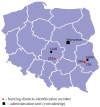European Brown Hare Syndrome in Poland: Current Epidemiological Situation
- PMID: 36366520
- PMCID: PMC9698305
- DOI: 10.3390/v14112423
European Brown Hare Syndrome in Poland: Current Epidemiological Situation
Abstract
European brown hare syndrome (EBHS) is one of the main causes of mortality in brown hares (Lepus europaeus) and mountain hares (Lepus timidus) in Europe. Since the mid-1990s, this highly lethal and contagious plague has been widespread in many European countries, contributing to a drastic decline in the number of free-living and farmed hares. A second lagovirus, able to infect some species of hares is rabbit haemorrhagic disease virus 2 (RHDV2; GI.2) recognised in 2010, a new viral emergence of RHDV (GI.1) which is known to be responsible for haemorrhagic disease in rabbits-RHD. The aim of this study was to evaluate the current EBHS epidemiological situation on the basis of the presence of antibodies to European brown hare syndrome virus (EBHSV) and anti-RHDV2 antibodies in sera collected from free-ranging hares in Central and Southeastern Poland in 2020-2021. Additionally, studies on the presence of EBHSV and RHDV2 antigens or their genetic material in the blood and internal organs taken from brown hares between 2014 - 2021 have been carried out. The results of the serological examination showed nearly 88% of tested blood samples were positive for EBHSV antibodies. No EBHSV was identified in the examined hares using virological and molecular tests. The positive results of EBHS serological studies confirmed the circulation and maintenance of EBHSV in free-living brown hares in Poland. However, no serological, virological or molecular evidence was obtained indicating that the brown hares tested had been in contact with RHDV2.
Keywords: EBHS; European hare; epidemiology; lagoviruses; serology.
Conflict of interest statement
The authors declare no conflict of interest.
Figures
References
-
- Edwards P.J., Fletcher M.R., Berny P. Review of the factors affecting the decline of the European brown hare, Lepus europaeus (Pallas, 1778) and the use of wildlife incident data to evaluate the significance of paraquat. Agric. Ecosyst. Environ. 2000;79:95–103. doi: 10.1016/S0167-8809(99)00153-X. - DOI
-
- Morisse J.P., Le Gall G., Boilletot E. Hepatitis of viral origin in Leporidae: Introduction and aetiological hyptheses. Rev. Sci. Tech. 1991;10:283–295. - PubMed
Publication types
MeSH terms
Supplementary concepts
LinkOut - more resources
Full Text Sources
Research Materials
Miscellaneous




